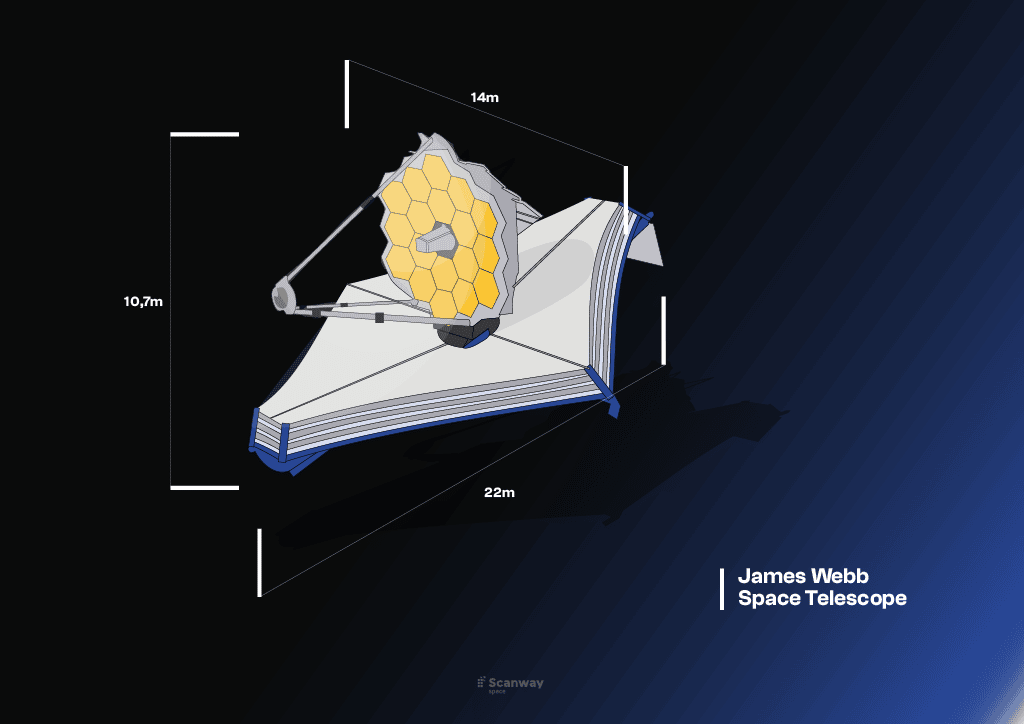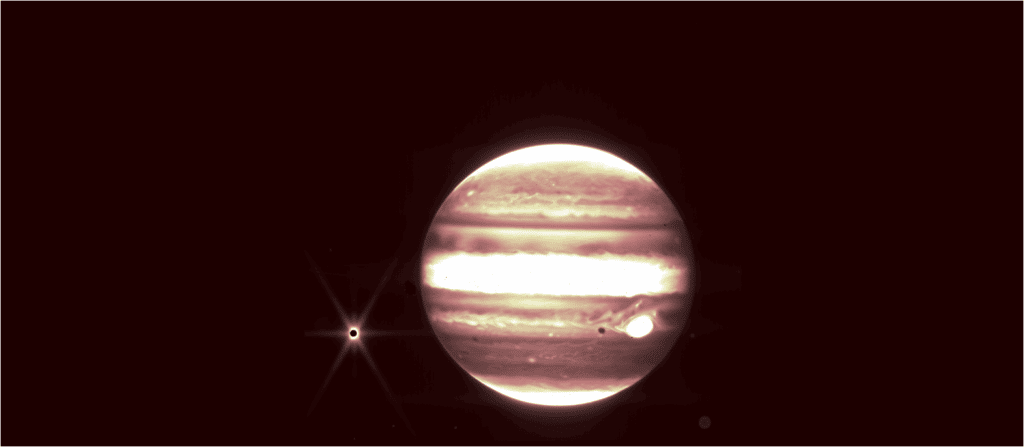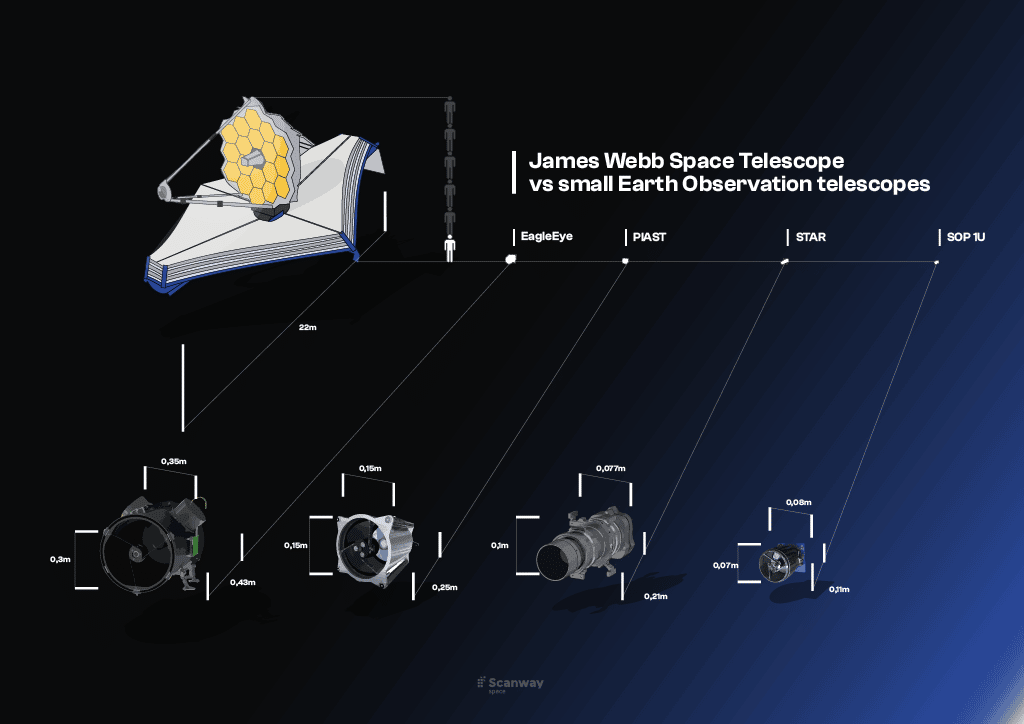Comparison of the James Webb Space Telescope to smaller commercial imaging telescopes
Craving for knowledge
Now we know what the light is, how it is measured and what are the spectra of the light. Now it’s time to talk about telescopes, that can observe Earth and universe. Telescopes are our “better eyes” when it comes to seeing things that can’t be (easily) seen by a human. We are going to compare Scanway’s four telescopes with the newest NASA telescope, the James Webb Space Telescope.
The beginnings of observation from space
The first telescope is said to be created by a Dutch eyeglass maker, Hans Lippershey in the 1608. In the beginning, the telescopes unsurprisingly were quite primitive. It must have taken many years for telescopes to begin to resemble those of today.
First space observatory that was successfully operational was American Orbiting Astronomical Observatory 2, named Stargazer, that was launched on 7th of December, 1968 on Atlas Centaur into a nearly circular, 768×777 km orbit. It had two main instrument sets and observed the Universe in ultraviolet spectrum. It focused primarily on planets, comets and galaxies.
Probably the world’s most famous telescope that everyone knows about, the Hubble Space Telescope, was launched on Space Shuttle Discovery on STS-31 Missions from LC39B from Kennedy Space Center on 24th of April, 1990 into a 569 km orbit. The mission to repair the flawed mirror was undertaken in 1993 and since then Hubble has provided many invaluable and world-renowned images (e.g. Hubble Deep Field) captured in multiple spectra: infrared visible and ultraviolet light.
Called Hubble’s successor, James Webb Space Telescope (in short JWST) is a joint venture mainly between NASA, ESA and CSA, After many years of delays and budget overruns, the telescope was launched on 25th of December, 2021 from Guiana Space Centre aboard Arianne 5 rocket. After stressful launch, a month long trip to its orbit (Lagrange L2 point between the Earth and the Sun) and another 5 months of starting up all the instruments and cooling them, the first images arrived on July 12, 2022, and immediately brought joy to the faces of astronomers. JWST operates in infrared spectre and is set to discover the unknown.
Observations from Space not only focus on different planets, comets or galaxies, but also on Earth. Everybody thinks of weather forecast, GPS services, reconnaissance or increasingly popular satellite internet. However, data observation from space may also help to track changes on Earth (e.g. deforestation, ice loss, cities expansion), help the agricultural industry by crop yields or measure humidity of the soil and also serve international security by observing countries in near-border regions. In this article, we will compare big, costly, yet superb telescope like JWST with smaller and versatile telescopes designed by Scanway to serve people on Earth.
James Webb Space Telescope
Telescope was launched on Arianne 5 rocket that has a 5,4 meter in diameter and 17 meters tall fairing. So some may think that this was the limitation of the telescope size – it wasn’t. After separating from the rocket JWST, apart from starting and cooling instruments, began deployment – e.g. solar arrays for power, sun shield for protection from the Sun and most importantly – its primary and secondary mirrors. Final dimensions are shown on the graph below.

Naturally, telescope of this size and complexity level isn’t cheap and easy to make. It was supposed to launch in 2007 and cost one billion USD. It launched in 2021, fourteen years later, and cost ten times more than planned. With a budget like that, some might assume that Webb can do and see anything – it can’t. Take a look at the photo below taken with a huge, twenty-five square metre aperture mirror – although it is beautiful, it can be admitted that it is not very detailed.

If this were Earth, it would be impossible to distinguish between rivers, lakes and mountains. It would certainly be a beautiful picture – but it wouldn’t be very useful for reconnaissance purposes. Not every telescope is designed for every purpose.
Scanway’s telescopes
At Scanway, we have designed (or are in the process of designing) four telescopes. During development, we focused not only on their capabilities, but also on their size, weight, and power and thermal requirements.
- 20 cm aperture telescope for EagleEye mission which is the largest observation telescope fully designed and constructed in Poland. It can be used for observation of urban development, agriculture, object recognition (cars, buildings) and defence purposes (civil and non-civil units location).
- 12 cm aperture telescope for PIAST constellation (Polish ImAging SaTellites). This telescope is a telescope dedicated for Polish Earth observation satellite constellation which is dual use – can perform tasks both for commercial and military purposes.
- 5 cm aperture STAR telescope for STAR VIBE mission (Small Telescope for Advanced Reconnaissance). It is the Earth observation satellite which is dedicated for observing natural disasters, climate change and to support agriculture.
- 6,5 cm aperture (1U fitting) telescope for DLR/GOS OTTER mission which is mission where telescope will visually verify marine vessel signals.
20 cm aperture telescope for EagleEye mission
As previously stated, EagleEye is the largest telescoped successfully developed in Poland. It’s a telescope that sees in four spectral bands. The first one is RGB or Red, Green, Blue, which is visible light. The fourth spectrum is NIR or Near Infrared, which is either reflected or absorbed by objects on the ground, making strong contrast possible. This is essential for high-resolution imaging.
EagleEye is designed to operate in the LEO at an altitude of 350 km, which an orbital period of 1,52 hours. Its optics will allow support for agriculture (e.g. crop condition and yield assessment), observation of urban development and classification of facilities. Object classification can, for example, support national security, especially in border areas. The telescope is designed is such way that the sensors can be swapped out, allowing it to operate in other spectral bands – e.g. SWIR.
Spatial resolution is 1,2 m (so each pixel is 1,2×1,2 m) and the field of view (FOV) is 4,9×3,7 km – both values calculated for a 350 km orbit. The very high spatial resolution and relatively small FOV means that EagleEye can photograph an area of approximately 2500 Wembley football fields with very high resolution which implies that our telescope can support very accurate and detailed data gathering.
The aperture is 198 mm (the diameter of the circle through which light enters the telescope) and the focal length is 1585 mm. The focal ratio (the ratio of the focal length to its aperture) is 8 – the higher the value, the faster shutter speeds are possible.
Dimensions and weight are very important factors in space. EagleEye fits into a box measuring 430x346x295 mm and weighs just under 8 kg. Low weight for such a powerful and capable telescope is a big benefit, since the cost of transportation to orbit increases with the mass of the payload.
12 cm aperture telescope for PIAST constellation
It is a dual-use telescope that can meet its requirements for both military use and commercial customers. It is intended for civil and defense object recognition in geopolitically crucial regions at a high resolution of 5 meters per pixel. Importantly, all components will be manufactured in Poland.
PIAST is going to operate from 500 km orbit and observe the Earth in panchromatic spectrum (PAN), which is a single spectrum combining the visible channels: Red, Green and Blue channels. Its field of view measures 20,5×15,4 km, the aperture is 120 mm and the focal length is 600 mm; hence the focal ratio is 5.
To reduce the cost of launch and the amount of space required, the telescope weighs only 1,8 kg and fits into a cuboid of just 250x150x150 mm.
5 cm aperture STAR telescope
STAR is an Earth observation telescope capable of taking images of our planet in the visible spectrum. With its capabilities it will be able to study natural disasters, climate change and to support agriculture. It is designed to operate in an orbit of 500 km with a spatial resolution of 25 m per pixel. Compared to EagleEye and PIAST, it has a much larger field of view (calculated for 500 km) of 102,4×76,8 km. The larger field of view is due to the higher orbit and shorter focal length of only 106,6 mm. Thanks to that, it is possible to conduct surveys much faster, having to make far fewer orbits to cover the same area.
Since the aperture is 50,8 mm, the focal ratio is only 2,1 – meaning the telescope can take pictures in low light conditions.
Despite its large capabilities, the telescope is very compact – it requires only 210x77x100 mm of space, and weighs only 1,2 kg.
6,5 cm aperture Scanway Optical Payload
Last but not least, Scanway Optical Payload 1U, is our smallest telescope (by its dimensions). Despite its small size and only 1,3 kg mass, its capabilities are definitely not insignificant. During the upcoming mission, it will be used to optically verify the signals of marine vessels, which are used to find their position.
The telescope will observe the surface of our planet in the visible – RGB spectral bands. It is intended to be placed at low LEO with an altitude of only 250 to 300 km. Thanks to its very low orbit and despite its small size (it needs only 70x80x110 mm volume), it can observe the Earth with a resolution of 10 m per pixel. An area of 40×28 km is visible in a single image, allowing it to quickly cover a large zone for a quick data analysis. The aperture is 65 mm, the focal length is 196 mm, that gives a focal ratio of just over 3.
Summary
All of our telescope have few identical parameters. Image resolution is 12 Mpix for all telescopes. Data format is 8,10 or 12 bits, acceptable data interfaces are I2C, SPI and LVDS. We have also focused on low power requirements: we only need 5 W for imaging and 5 or 12 V. Athermal design of the telescopes means that the equipment is resistant to temperature fluctuations. Because they are all designed in-house and based on our original optomechanical and optoelectrical ideas and solutions, we can easily make changes which improve telescopes capabilities. What’s more, designing optical and electronic parts in-house reaffirms our belief that telescopes can operate reliably in the harsh space environment. In addition to these values, our telescopes have one thing in common – they are designed to be the best possible for our customers. Each telescope is a compromise in many parameters – but looking at the whole, we can say that there is no compromise in imaging capabilities.

James Webb Space Telescope is amazing when it comes to space exploration, but Scanway’s telescopes are the ones that will do the best job when it comes to Earth observation. You don’t need a 10 billion dollars telescope and fourteen years delay in order to gather accurate data from out home globe.
If you have any further questions or are interested in our products, please feel free to contact us at [email protected].

